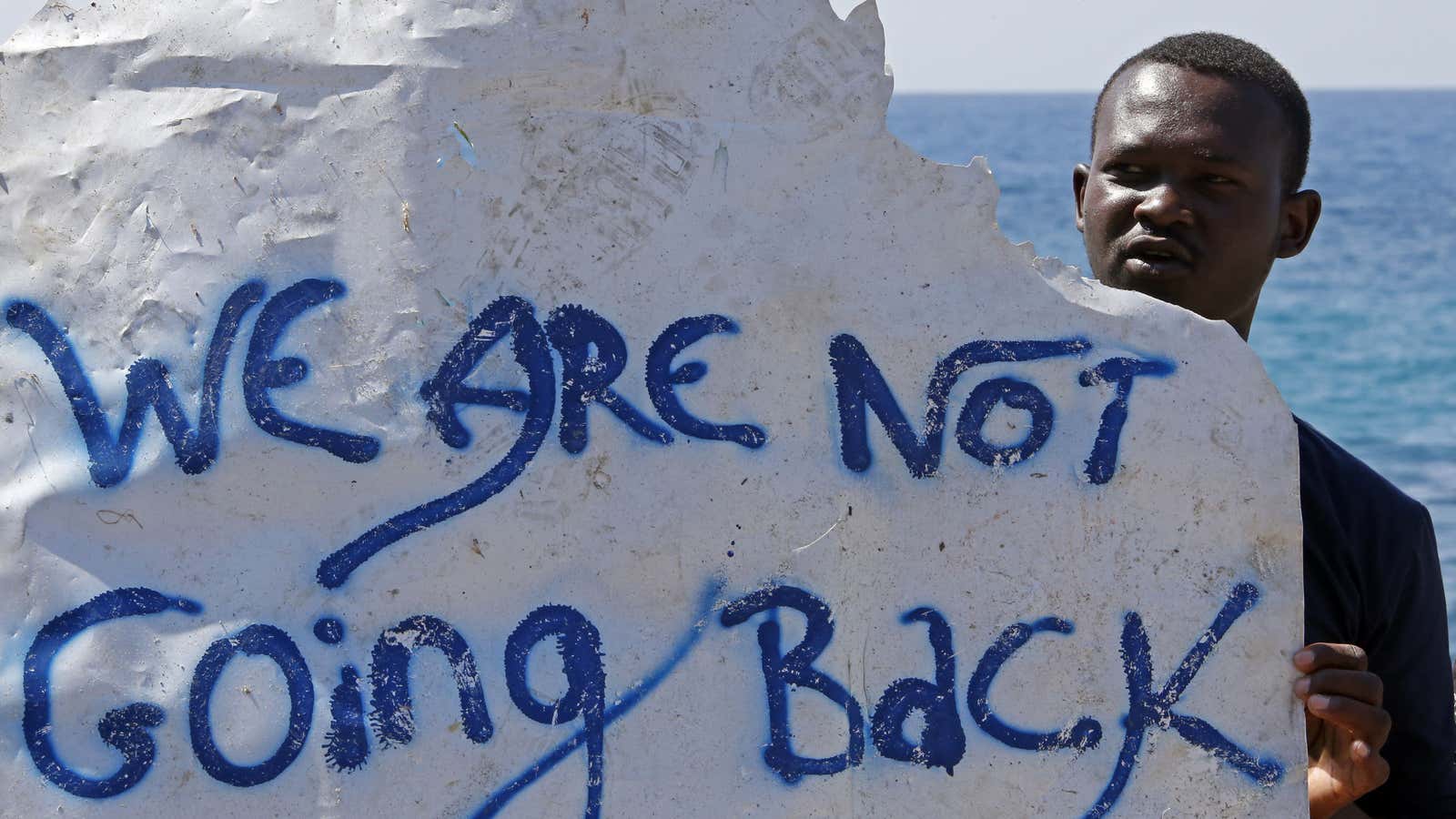On April 19th, an overcrowded fishing boat due for Europe capsized in the Mediterranean Sea. It was the most notorious incident of its kind in a year that has seen a spike in migrant shipwrecks (pdf). Up to 900 people died, many of whom had been locked below deck. Of those 900, the largest group, estimated at 350, were from Eritrea, a country of about 6 million people on the Horn of Africa.
Despite its small size and relative isolation, Eritrea has accounted for the second-largest number of migrants to Europe last year and so far this year—trailing only Syria, which is currently in its fifth year of civil war. Approximately 35,000 Eritreans arrived in Europe in 2014, according to Frontex (pdf), a 206% increase from the previous year; 48,000 thousand applied for asylum, per the UN High Commissioner for Refugees, a 119% increase.
In an attempt to stem the flow, the EU is boosting its aid to Eritrea. It says the money is meant to help tackle poverty and create jobs. But the real cause of Eritrea’s exodus has very little to do with lack of economic opportunities. Its people have for years been fleeing a repressive military dictatorship that forcibly conscripts young men for indefinite periods and treats prisoners like animals. Their stories are key to understanding the roots of the refugee crisis—and why the EU’s aid package looks like an attempt to paper over it.
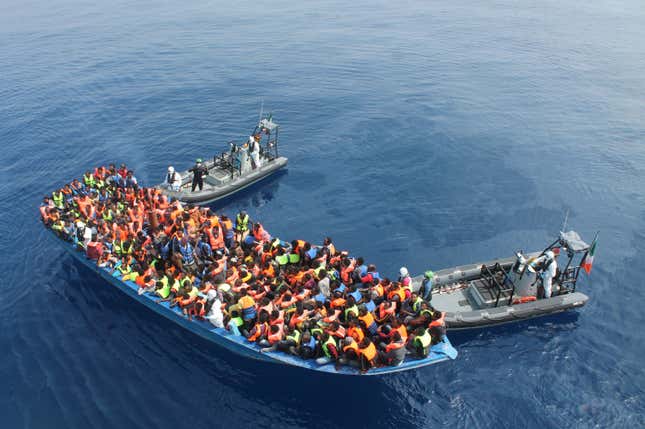
A Kafkaesque ordeal
Although the numbers are increasing, exile is not new for Eritreans. There were more than 357,000 Eritrean refugees in the world as of mid-2014, according to the UN (pdf, p. 42), and another 5,000 leave the country every month. In 2010 the World Bank estimated that some 941,000 Eritreans (pdf, p. 112), including non-refugee emigrants, were living abroad.
The biggest refugee communities, each over 100,000 strong, live in neighboring Sudan and Ethiopia. Some 36,000 are in Israel, which they used to be able to reach from Egypt by crossing the Sinai desert. But in 2013 Israel finished a border fence, shutting off that route and precipitating the rise in migration to Europe. Those who made it to Israel live precariously, with most denied refugee status.
I spoke to several of these asylum seekers in Israel. One of them is Tesfalasie (not his real name). In 1998 he entered the University of Asmara, Eritrea’s only university. As a student he was exempted from military service; that allowed him to escape the senseless 1998-2000 Ethiopian-Eritrean war, which killed between 70,000 and 100,000 people, including one of his brothers.
In 2001, a large international organization engaged students from the university to survey the war’s damage and casualties. Before the survey commenced, however, the government cancelled the project and confiscated the funding. The student body president challenged the decision and was arrested. His fellow students, including Tesfalasie, protested. Shortly thereafter, soldiers and police gathered up the students, beat them viciously, and sent them to a prison in Wia, a coastal area on the Red Sea, where temperatures can reach up to 120°F (49°C) in the summer. They spent 45 days there; two students died from the heat.
Their ordeal was part of a larger crackdown on Eritrean civil society in 2001. After the government had indefinitely postponed a scheduled election, 11 high-profile figures—generals, ministers, ambassadors, members of the ruling party, and former fighters—and their associates had called for democratic dialogue and rule of law. They were arrested, and their fate is still unknown. All independent media, including eight newspapers, were shut down, and prominent journalists were arrested.
Tesfalasie and his fellow students were released only after agreeing to not speak out again. He finished his studies and started a job as an administrator at a school. But a few months later, he and other former students were rounded up and sent to a military training camp. After three months doing manual labor, they were dispersed once more; Tesfalasie was transferred to a naval training center.
There he was to spend three-and-a-half years in a truly Kafkaesque nightmare. He was given a military uniform and a room near the commander, and forbidden to speak to anyone but the commander. He was given nothing to do other than make roll-call twice a day. If he approached someone, they moved away; if he tried to speak, he was beaten.
Finally, during a general meeting on the base, Tesfalasie could take it no longer. He raised his hand to ask a question. The commander snarled at him to stay quiet; Tesfalasie answered back in an outburst of anger. Other soldiers attacked and beat him until he collapsed. Then he was put in a prison within the base, where he would spend another year and a half.
As documented by Amnesty International and other human rights organizations, Eritrean prisons are abominable places. Some, like the one Tesfalasie was held in, consist of pitch-dark underground cells; he could sense the other six prisoners in his cell by sound only. Other jails are simply metal shipping containers, often located in the desert, where prisoners suffer extremes of heat by day and cold by night.
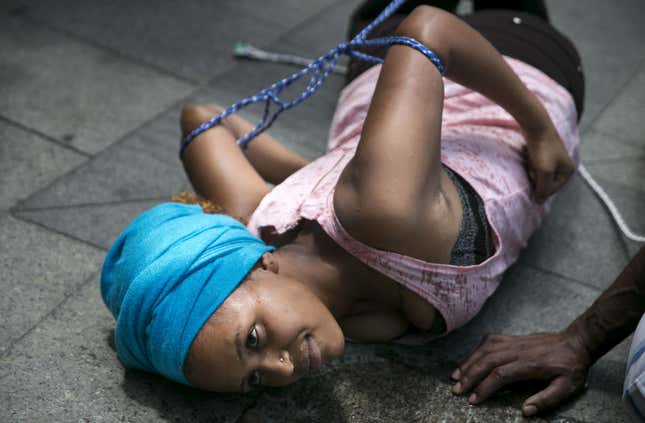
Torture is common, meted out during interrogations or for minor infractions. Former detainees report that prisoners are often tied up in contorted positions for almost 24 hours a day, with breaks only for food and the toilet. Cells are overcrowded and some prisoners die from exhaustion, malnourishment, or lack of treatment for diseases. Tesfalasie and his cellmates were let out just once a day to use the toilet, and prisoners who fell sick were left to wallow in their own excrement. Like many, he was held incommunicado; his family managed to learn where he was, but could not talk to him or visit.
It was during the daily toilet break that Tesfalasie, blinking uncontrollably in the sunlight that his eyes could now barely tolerate, heard a voice: “Ay, Tesfalasie! What are you doing here?” It turned out to be a man who had grown up with him in the same small village. The man asked what he could do to help.
“Don’t die for me,” Tesfalasie responded, “I am already dead. Let me die.”
The man demurred, and managed to take Tesfalasie aside and lead him away from the jail. After they had parted ways, Tesfalasie made his way to a nearby city, where residents gave him fresh clothes and a new pair of shoes—his clothes had not been changed once during his year and a half in the jail—and dropped him off near the northern border with Sudan. He crossed it using a bush as camouflage, while the local military base took its evening roll-call. Sudanese soldiers picked him up and took him to a nearby refugee camp. Altogether, his ordeal at the naval base had lasted five years.
Yet even here he was not safe. Other Eritreans at the camp told him refugees could still be captured there and returned to Eritrea. He traveled to the Sudanese capital, Khartoum, and thence northward to Egypt. Mindful of Eritreans who had been deported from Egypt and subsequently disappeared into jail, he made the journey across the Sinai to Israel, where he arrived in December 2007.
An army of slave labor
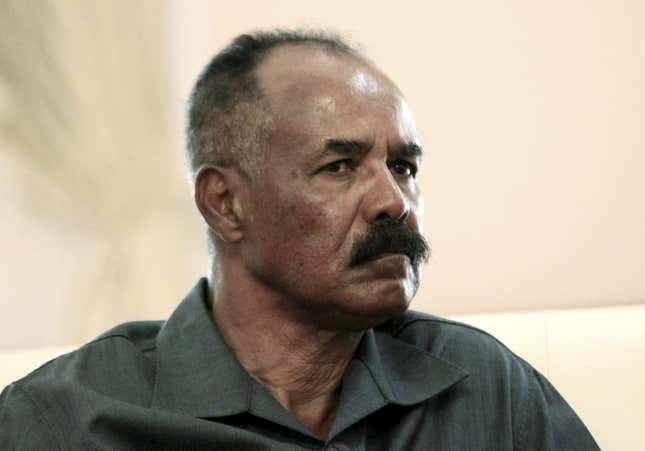
Eritrea is a young country. It gained independence in 1993 after a 30-year war with Ethiopia. Since then it has been ruled by Isaias Afewerki, a former fighter and the leader of the country’s only political party. After the 1998-2000 war, the government’s authoritarianism accelerated and its political isolation deepened: It currently ranks last on Reporters Without Borders’ Press Freedom Index, worse than North Korea.
In 1994 it established a “national service program,” supposedly as a means to foster a cohesive national identity. Conscripts were supposed to serve for 18 months. The first four cohorts in the program were demobilized, but were called back into action during the 1998-2000 war. Since then there have been no mass demobilizations, and individual exemptions are rare.
Teklit was not supposed to be one of these soldiers. He was a promising long-distance runner who studied and trained at one of the country’s biggest athletic development clubs. This should have protected him from military service. But at 17 he was arrested after someone—possibly one of his fellow athletes—informed on him for privately expressing views critical of the state.
After three months in jail, where he was chained by his hands and legs, Teklit was stripped of his exemption, drafted, and sent to a desert camp in the country’s western lowlands. Like in much of Eritrea’s “military” service, his work had little to do with the military. Teklit and his fellow “soldiers” had to manufacture thousands of manure bricks every day. Another refugee I talked to in Israel spent seven years doing agricultural work on an army commander’s farm. More recently, the country opened up its mining industry to foreign investment and Human Rights Watch alleged that conscripted soldiers were being used to build infrastructure at the country’s only operating mineral mine, majority-owned by Nevsun Resources, a Canadian company. Three Eritrean workers are suing Nevsun in Canada; it denies using conscripts as labor.
Enlisted “soldiers” reportedly get a monthly salary of approximately $33, not enough to cover basic needs. Because their service period is indefinite, this is effectively a state-run slavery system. Two of Tesfalasie’s brothers, one in his forties and one in his fifties, are still soldiers in the army, even though he says one of them can no longer hold a gun. “I don’t know people that were let out of the military, nobody that I know,” Teklit told me.
With a friend, Teklit began plotting his escape from the country. They snuck off their army base in August 2006, after about a year of service, and walked 20 hours without food or water to the northern border, and thence to Sudan and Israel. On the way to the border they encountered an army colonel who tried to shoot them as they ran away; other Eritreans have similarly testified that, like East Germany before it, the Eritrean army opens fire on citizens trying to flee the country.
The government also exacts penalties on the families of people who escape. Teklit’s family members were denied the chance to attend university. According to Amnesty International, the government has levied fines of approximately $3,800 (pdf, p. 32) against the families of military-service deserters and evaders. It also levies a 2% “diaspora tax” on the earnings of Eritreans living abroad, effectively monetizing the exodus its policies have created, and enforces it using extortion and threats; the UN has accused Eritrea (pdf, p. 3) of using the money to fund armed militias such as al-Shabaab.
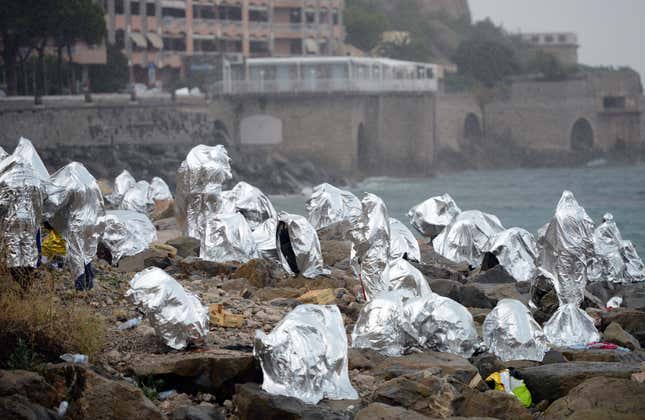
The EU’s hypocrisy
Announcing the EU’s new development aid package to Eritrea in March, European commissioner Neven Mimica was paraphrased by Reuters as saying that the aid would “address social and economic exclusion in migrants’ countries of origin in a bid to halt the crisis.” An early report valued the package at €312 million ($344 million) over five years, though an EU spokesperson told Quartz the figure is in fact still being discussed. The EU’s previous five-year aid package was worth €122 million, of which less than half was spent.
Asked about the motivations behind the aid increase, the spokesperson gave three reasons: “to address the root causes of poverty and support the wider population;” “because engagement (not isolation) creates the possibility for dialogue through which we can… insist on the importance of adhering to international standards on human rights;” and “to contribute to peace and stability in the country and wider region and prevent conflict.”
That implies that Eritreans fleeing their country are economic migrants, and that engaging more with the Eritrean regime might get it to change its behavior. But there’s little evidence for either claim.
While Eritrea is, indeed, a poor country, it is no poorer than neighboring Ethiopia, nor than Niger, which borders Libya. Neither of those has experienced a similar exodus. And if Eritreans are mainly seeking better economic opportunities, or the human-rights situation isn’t that bad, why did European nations grant asylum to 88% of Eritrean applicants last year?
“The regime. The root cause is the regime that is driving people out of the country,” said Meron Estefanos, a Swedish-Eritrean journalist and activist who is well-known in the Eritrean diaspora. “We’re not talking about a government; we’re talking about a mafia-like regime that extorts its people; that exploits its people; that makes money in the name of its people.”
Selam Kidane, an Eritrean human rights activist in the UK, estimated that up to 90% of those fleeing are national service soldiers. She also noted a recent increase in minors, whose parents want them to avoid the draft altogether. Both Estefanos and Kidane believe that the development aid is underpinned by a tacit agreement that Eritrea will tighten its border controls and stanch the flow of refugees.
The idea that “engagement” with the regime will lead it to improve its human-rights record also seems implausible. The situation in Eritrea has, by all accounts, deteriorated substantially since the previous round of EU development aid, in 2008. In 2009 and 2011 the UN imposed sanctions on the country for its alleged support of al-Shabaab in Somalia. It has been involved in direct and proxy conflicts with all of its neighbors, and is almost certainly the only country in the world to host both an Israeli and Iranian military base. Last month, a new UN report (pdf, p. 449) said Eritrea’s “violations in the areas of extrajudicial executions, torture (including sexual torture), national service and forced labour may constitute crimes against humanity.”
The endless search for asylum
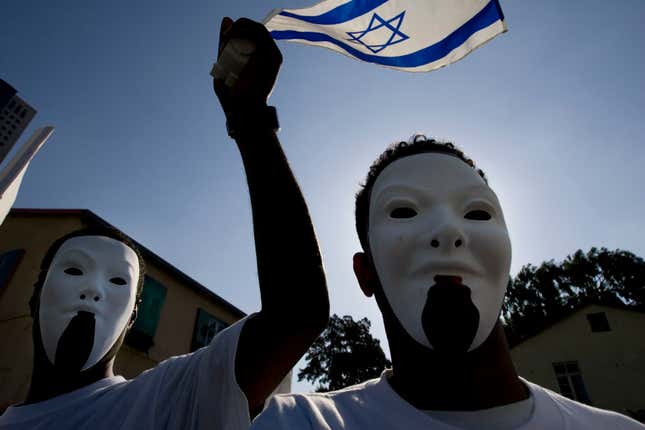
In Israel, Tesfalasie and Teklit are stuck in limbo. Both have been there for at least seven years, but as of February, the government had approved just a tiny handful (paywall) of the applications from African asylum-seekers. (For comparison, 84% of Eritreans are granted refugee status or similar protections elsewhere.) They suffer frequent racist attacks and police harrassment. The Israeli government recently said it would start deporting asylum-seekers to Africa and indefinitely imprison any who refuse; human-rights groups are fighting the policy (link in Hebrew).
Both men say they want to return to Eritrea—when the government falls.
“You know, your country and your mom. There is some degree of connection,” Tesfalasie told me, “You love mom more, but after that you love your country. How could I stay? I am always praying [to return], to see my mom.”
